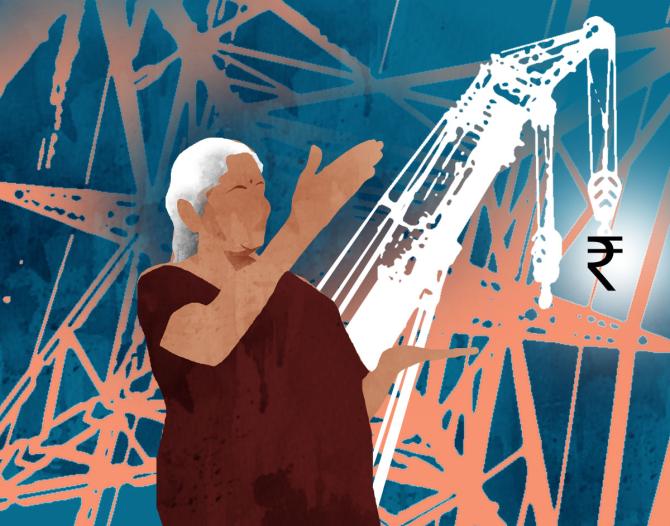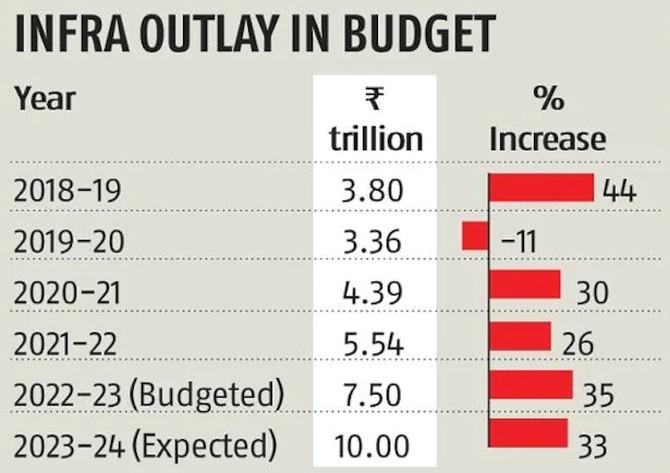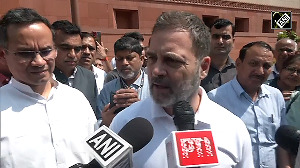7 key areas that the Budget must address to re-energise the infrastructure sector, suggests Vinayak Chatterjee.

The last few years have demonstrated a certain consistency in prioritising infrastructure outlay and recognising it to be the pump-primer of economic growth.
The accompanying table shows the high growth in outlays for the infrastructure sector.
The expectation is that the 2023-2024 Budget will keep up with this trend with a 33 per cent increase, which will take the outlay to Rs 10 trillion.
A confidential report cited by top finance ministry officials during post-Budget discussions last year states that every Rs 1 spent on direct benefit transfer schemes results in Rs 0.90 of economic growth, whilst Rs 1.0 spent on infrastructure adds Rs 3.0 to gross domestic product.
With this view dominant amongst finance ministry mandarins, a Rs 10 trillion outlay, representing a 33 per cent increase over last year, is very much in order.
The next priority area is the financing of urban infrastructure.
Two recent reports -- the maiden report by the Reserve Bank of India on municipal finances, and the World Bank's report on financing India's urban infra needs, point to serious deficiencies.
The World Bank report estimates that India will need to invest $840 billion (Rs 6.9 trillion) over the next 15 years in urban infrastructure.
With municipal capacity-building measures emphasised in the finance minister's last Budget speech, this Budget is widely expected to come up with a special package for promoting municipal bonds.
It could possibly have incentives like central government participation, credit enhancement and interest subvention as measures to kick-start this vital capital market instrument.
A serious concern currently is the slowdown in the combined investments of states on public works.
As a thumb rule, states contribute about half of the national investments. Whilst central government investments have been robust, data point to a worrying slowdown of capex by states in the first seven months of this fiscal.
The Union Budget needs to take cognisance of this. It did have a Rs 1 trillion support scheme for sponsoring state infra; such a provision could now be tweaked to incentivise state spends -- say, by a 'cash back' of 10 per cent of the project cost of every completed state-level project, to be used for fresh projects.
The next big challenge is getting the private sector to invest heavily again.
Barring telecom, data centres and renewable energy, the private sector's appetite to invest in greenfield projects remains subdued.
In her last Budget speech, the FM had said: 'Measures will be taken to enhance financial viability of projects including PPP (public private partnership).'
The visible measures taken to date on PPP revival include setting up of the Infrastructure Finance Secretariat (IFS), as an extended arm of the Department of Economic Affairs.
The IFS could, this year, step up to take a more aggressive role in PPP revival, especially in crafting a PPP framework to address the requirements of the health and education sectors.
The FM has already indicated that health and education would be in focus in the forthcoming Budget.
It is acknowledged that budgetary outlays will be insufficient to address the humongous needs of these two sectors.
Hence, the IFS should strive to construct a scheme where Rs 1 of government expenditure is leveraged by Rs 5 of private contributions.
On sustainability, the Budget needs to recognise its role in setting out a national action-agenda.
It needs to consider setting up a specialised development finance institution for financing climate change mitigation and adaptation, or encourage the National Bank for Financing Infrastructure and Development to do the same with the support of a concessional line of financing.
A task force to examine the concepts of carbon tax and carbon credits trading system relevant to India, is in order, as a follow-up to the mandate given to the government by Parliament's nod to the Energy Conservation Amendment Bill, 2022.
It should consider a production-linked incentive scheme for electrolysers to encourage production of green hydrogen and include green ammonia and green hydrogen installations under the harmonised list of infrastructure sub-sectors.

After the abolition of the standalone Railway Budget, details on railway finances have been less than forthcoming.
A Comptroller and Auditor General report on the finances of the railways had candidly pointed out that the operating ratio (OR) does not reflect the true financial performance.
It reported that against the stated OR of 98 in 2019-2020, it should realistically have been 114 if the actual expenditure on pension payments was taken into account.
There have been other issues too in the past on booking expenditure under different heads, such as safety and maintenance.
It is heartening to note that the railway minister has committed to make the OR number transparent in all respects.
The Union Budget should provide greater depth and analysis, considering that allocations to the railways are expected to rise at a faster rate than roads.
On infrastructure intermediates, cement is the elephant in the room.
It is an 'aam aadmi' commodity as well as a crucial input for large-scale infrastructure build-out.
The Union Budget would do well to pronounce on whether it is desirable to continue taxing cement at the high slab rate of 28 per cent, now that there is revenue buoyancy in the goods and services tax collections.
Individuals use more than 65 per cent of cement produced, and the non-availability of input-tax credit hurts this segment the most.
Decreasing the costs of public works and providing widespread relief on smaller construction works may be far more impactful in terms of economic development than the short-term revenue foregone.
The Budget speech could mention referring this to the GST Council.
With these seven brushstrokes, the Union Budget could once again seek to re-energise the infrastructure sector.
Vinayak Chatterjee is an infrastructure sector expert. He is also the founder and managing trustee of The Infravision Foundation.
Feature Presentation: Rajesh Alva/Rediff.com












 © 2025
© 2025